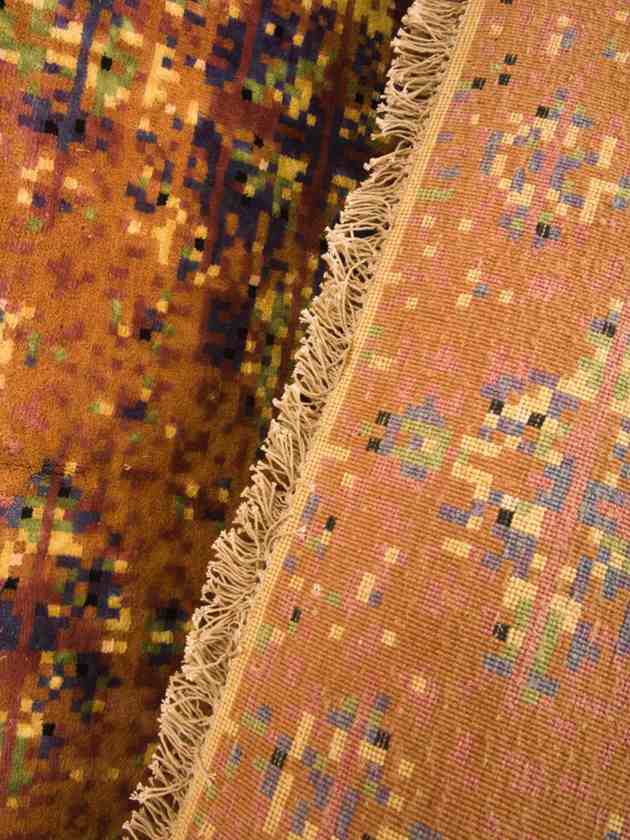


Carpet design is a key aspect of interior design that makes use of textile artefacts. It is so important since these decorative elements can transform the look of a room in a very distinct way and can add personality to any space.
As a result, understanding how a carpet design is arrived at and what the different elements that make up the final product are helps to make choices that are more informed and that help achieve a truly unique result.
One cannot talk about luxury carpet design without analysing the production process of these particular pieces of furniture. Specifically, the way in which individual products are processed and manufactured may vary depending on the area of production or the end result you want to achieve, however, generally speaking, there are three main steps involved: material selection, weaving and product finishing.
So how does it work? And how is the design of a carpet determined? It’s easy to say: once the yarns to be used have been chosen, the carpet can be made by hand or by machine. Handmade carpets, such as knotted carpets, require time and skill, often resulting in unique and very valuable pieces. Machine-made ones, on the other hand, are certainly cheaper and more suitable for large-scale production. They are also generally somewhat less durable and prestigious.
Knotted, woven and braided carpets are made by working the warp and weft together. The former represents in the truest sense of the word the design of a carpet. On the other hand, the second is the skeleton of the artefact. Thickness, pile height and compactness of the product are all factors that are defined at the processing stage.
The design of a carpet that is obtained at the end of the production process varies greatly depending on the furnishing style from which it takes its inspiration. Some examples of what we have just stated? While Oriental carpets remain a timeless classic and have a strong furnishing capacity due to the presence of floral decorations and intricate workmanship, modern designs focus on geometries, textures and colour combinations that depart from tradition.
The shape of the carpet also influences its appearance. Indeed, in addition to considering the typical rectangular, round or oval models, rugs with irregular shapes can also be considered, which are perfect for adding an artistic touch to the room. Current trends in carpet design suggest the use of oversized patterns to define open spaces. Alternatively, you can opt for the use of natural and sustainable materials to emphasise the naturalness and eco-friendly character of the furniture.
The first thing to do when choosing a carpet design is to weigh up the pros and cons of traditional and oriental styles. Each option has its own unique design and look, which must be considered carefully, not forgetting the presence of intermediate nuances between these two extremes.
Traditional carpets, such as Persian carpets, are famous for their intricate geometric or floral patterns, which often carry symbolic meaning. Intense colours and natural materials, such as wool or silk, give these textiles an elegant and timeless appearance.
Contemporary carpets, on the other hand, are notable for their more minimalist design, use of clean lines and greater colour variety, ranging from neutral tones to bright colours. Pieces belonging to this category are perfect for furnishing modern rooms, as they can give any room or business premises a fresh and versatile look.
Carpets with a contemporary design are also very versatile in terms of the materials used. Indeed, alongside the more common fibres, such as wool and cotton, there are also more niche natural fibres, such as hemp and jute, or synthetic fibres, which are mainly used for outdoor carpets.
Those who want to achieve an original and customised result can consider carpet design that mix traditional and modern elements. For example, a pattern with stylised oriental motifs and modern colours can be a good compromise for those seeking a balance between past and present.
Last but not least, the custom-made carpet . That’s right, because carpet design can also be fully customised to meet the customer’s requirements.
When choosing a carpet, the importance of the product’s decorative patterns and textures should not be underestimated. Among the most commonly used patterns for carpet design are geometric patterns, floral designs, abstract motifs or even damask patterns.
Each pattern refers to a specific style and conveys different messages. A few examples? Patterns with geometric designs are modern and rigorous, whereas floral patterns are more classic and delicate.
Texture also plays an important role in the success of interior design using textiles. Indeed, the length of the pile, the thickness of the individual item and the workmanship of its surface influence the appearance and user experience of the specific pattern.
Nodus has always created exclusive products that furnish the most beautiful homes in the world. Do you want to make your home inimitable as a work of art?
Bring a hand knotted rug of the highest quality and design into the spaces of your daily life! Give your family and the people you love the beauty of a dream masterpiece! Every piece of Nodus is designed by famous Designers, making it recognisable and prestigious. In this way, each rug is unique: you will not find another one like it. Like all beautiful and unrepeatable things, one piece in the Nodus collection sets you apart and speaks to others about your taste and elegance. CONTACT US!
Statement rugs become the real protagonists of a space and are able to transform the…
Custom carpet rugs play a fundamental role in interior design because they allow you to…
Stylish rug: The current trends in the world of interior design see stylish rugs, both…
Looped rugs are an excellent solution for furnishing the rooms in your home or even…
Custom area rugs are an exclusive design choice that allows you to find the perfect…
Custom art rugs are a choice that allows you to benefit from both the elegance…